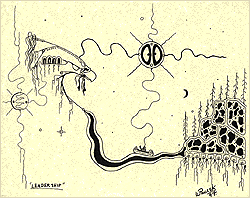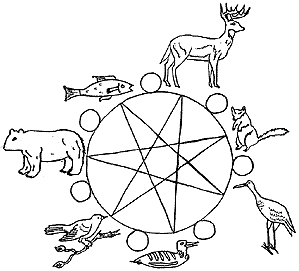
Chippewa Leadership Drawing

Name(s) of Tribe: Chippewa,
also known as Ojibwe or Anishinabe.
(Ojibwe and Chippewa are actually even the same word,
just pronounced differently with accent).
The Chippewa have never received due
credit for their successes. They were the largest and most powerful
tribe in the Great Lakes area. The Sioux get more press, but the
Chippewa were the tribe who defeated the Iroquois in wars, and forced the
Sioux from their native lands. The Chippewa were located well north
of the early flow of settlement, so they rarely had any conflicts with
settlers. The Chippewa never had any conflicts with Americans after
1815 and have signed 51 treaties with the U.S. government, more than any
other tribe. They've also signed more than 30 treaties with the French,
British, and Canadians.
However, most Chippewa lived in the northern Great Lakes with a short growing season and poor soil. They were hunter-gatherers who harvested wild rice and maple sugar. Woodland Ojibwe had no salt to preserve food and generally mixed everything with maple syrup as seasoning. They were skilled hunters and trappers. Fishing, especially for sturgeon, provided much of their diet and became progressively more important in the northernmost bands. Woodland Ojibwe rarely used horses or hunted buffalo. Dogs were the only domestic animal and a favorite dish served at their feasts. Bark from birch trees was very important to the Chippewa. They used birchbark for almost everything: utensils, storage containers, and, most importantly, canoes. Coming in a variety of sizes depending on purpose, the birchbark canoe was lighter than the dugouts used by the Sioux and other tribes. Birchbark was also used to cover their elliptical, dome-shaped wigwams. When a family moved, the covering of the wigwam was rolled up and taken along leaving only the framework.
The hunter-gatherer lifestyle of the Ojibwe required they separate into small bands moving in a fixed pattern to take advantage of available resources. Polygamy was rare. During winter, they separated into extended families in isolated hunting camps which allowed the men to cover a large area without competition from other hunters. During warmer months, they gathered in bands of 300-400 at known locations where fish, berries, and wild rice were abundant. There was little central organization, and the authority of hereditary Ojibwe chiefs before contact was limited and confined pretty much to his own band. Tribal councils occurred only when several bands made common cause in times of war but otherwise were rare. However, this changed after the beginning of the fur trade with the French, and the different bands began merging.
Ojibwe scalped, but as a rule they killed and did not torture. Like other Great Lakes warriors, there was ritual cannibalism of their dead enemies.
The Chippewa spoke a form of the Algonquin
language. Ojibwe is virtually identical to Ottawa, Potawatomi and
Algonkin, with a more distant relationship to Illinois and Miami. After
1680, Ojibwe became the trade language in the northern Great Lakes area.

Chippewa Clan System Drawing
Relevant Links